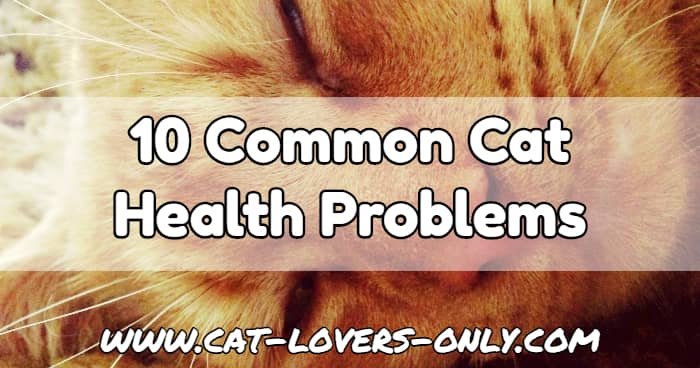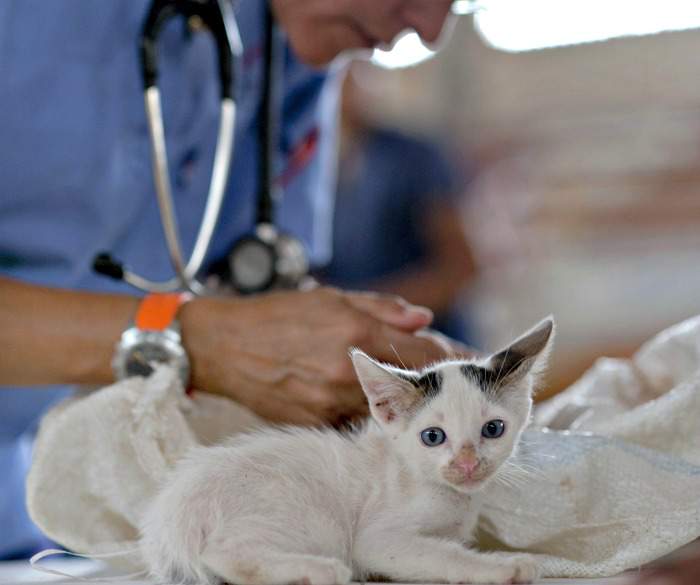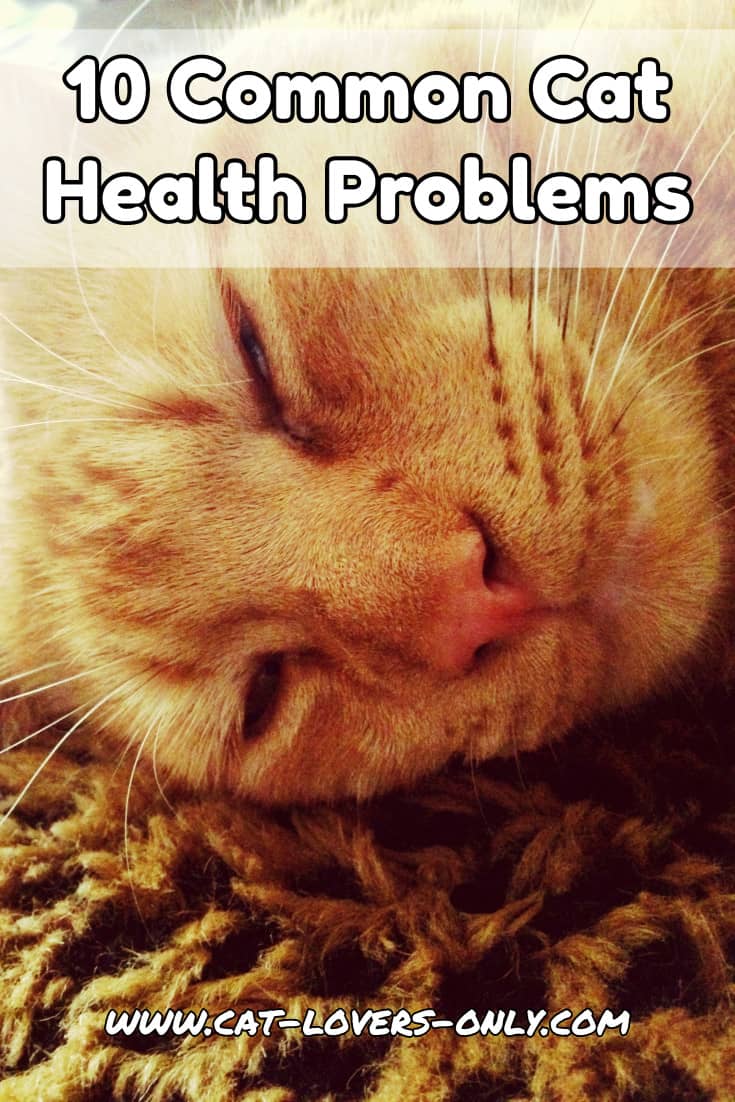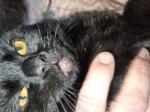10 Common Cat Health Problems
Some common cat health problems you may encounter in your pet with links to detail where available are listed here.
This is not, by any means, an exhaustive list.
As your cat ages, elderly cat health problems become more of a concern, so if you've got a senior kitty at home, you might want to pounce on that page after you devour this one.

Keep in mind that parasite and rodent control, sanitation, and exposure to infected cats or areas where infected cats may frequent are important in controlling many health conditions.
In cats, infectious diseases are often passed through saliva (biting and licking), and feces.
Some, however, may be spread through the air, or the germs may linger on surfaces.
As such, there tends to be higher incidents of infection where crowded conditions exist, such as in catteries or neighborhoods where cats roam, and the feline population density is high.
Parasites are often passed in feces and cats that roam are more likely to become infected simply by stepping on infected ground.
*As always, if you suspect your cat may be ill, contact your veterinarian.
1. Feline Diabetes and Endocrine Disorders
A common disorder in cats, feline diabetes (diabetes mellitus) often affects older obese males, but is not exclusive to that group. Diabetes can present a bit differently in each cat, and can lead to some other very serious health issues.
With treatment, however, a diabetic cat can live many good years, and some even lose their need for treatment over time. Excessive thirst (polydipsia) and urination (polyuria) are the classic signs of diabetes in cats, so be alert to these symptoms and seek veterinary advice (more on feline diabetes symptoms).
Another fairly common occurrence is feline hyperthryroidism (over-active thyroid typically caused by benign tumors). This can also have accompanying heart abnormalities, including cardiomyopathy. According to my research, most other endocrine disorders in cats, such as Cushing's disease (hyperadrenocorticism) seem to be relatively rare.
2. Hairballs
Hairballs are very common and a major cause of constipation in cats. The barbed tongue of the feline that gives it the rough sandpaper feel pulls the licked fur towards the back of the throat where it's swallowed.
While in the digestive tract, the fur binds together with food. Researchers have seen a large fat content in hairballs in cats. Sometimes the cat can bring up the hair ball, and sometimes the hair just has to go all the way through, where it may cause constipation.
Grooming your cat frequently can help prevent hairballs, and having the proper grooming tools can help.
3. Ringworm
Ringworm (dermatophytosis) is actually not a worm, but a fungal infection transmitted through spores. It is the most common infectious skin disease in cats. Some cats may show no symptoms but can still spread the disease (carriers).
Ringworm can be hard to cure, and the spores may be hard to get rid of as they may linger. The good news is that in an otherwise healthy feline, this disease may resolve itself (known as a self-limiting disease).
4. Parasites
Parasites are quite common in cats, and can be present even when your kitty shows few symptoms, or none at all. The presence of parasites, however, can weaken a cat's resistance to other diseases. This makes it possible for secondary conditions, such as infections, to take hold do more harm than usual.
There are various types of parasites, including worm-like variants and single-celled organisms. Some of the more common worms in cats are hookworm, roundworm, and tapeworm.
Worms are one of the most common cat health problems and your cat should be tested for worms at least yearly. Kittens are treated as a matter of routine, whether they test positive or not.
Some recommend deworming medication as a regular maintenance treatment, but more conservative veterinarians would recommend you deworm as needed. My cats, for example, have never been on any deworming medication, with the exception of when they were treated as kittens. They are tested yearly, and have never had worms, so there has never been any need to medicate them.
Flea control is vital as these creatures will cause infection of other parasites, such as tapeworms. Again, some would say that your cat should be on regular flea control, but mine have never had fleas, so there has never been a need for it.
Members of the single-celled variety of cat parasite include Isospora, Giardia, or Toxoplasma gondii (which causes Toxoplasmosis).
Since many cat parasite infections are passed from cat to cat, the chances of infection are greater in places with large cat populations and overcrowding, such as shelters. Infection rates can be as high as 45 percent or more.
Some cat parasites have the potential to infect humans as well. For these zoonotic diseases, parasite control is important to human health as well as that of the cats involved.
There are also some external parasites that cause additional direct and indirect cat health problems.
If you're concerned about the environment and the health implications of using chemicals and pet medication, there are a number of alternative solutions for natural parasite control and treatment. For example, here are some natural flea killers.
5. Respiratory Conditions
Respiratory (pulmonary or lung) conditions are common cat health problems. A busy emergency veterinary practice may typically treat many cases in a year stemming from a wide variety of causes.
These conditions can be either chronic or acute, and commonly stem from allergies, growths (either benign or cancerous), parasites, abscesses, adverse reactions to inhaled fungi, and the malfunction of other vital organs (such as congestive heart failure).
Some respiratory infections in cats may be secondary to a more serious condition or illness.
Upper respiratory infections (URI's) are extremely common in cats. According to Cheryl Yuill, DVM, of VCA Hospitals, the felineherpes virus type-1 causes Feline Viral Rhinotracheitis (FVR), and is a major cause of upper respiratory disease in cats. It's also the most common cause of conjunctivitis (if you've ever seen a cat's third eyelid, you know what I'm talking about).
6. Viral Infections
The HSUS tells us that many cat illnesses can be prevented by keeping cats indoors, and getting the proper vaccinations. Ensure that you talk to your vet about vaccinations and understand the benefits and risks. Many deaths occur due to common cat health problems that could have been avoided completely by proper vaccination.
Cats may contract viral infections just like humans, and may get the flu (see upper respiratory infections above). Sometimes, a cat will have a virus of non-specific origin.
If the illness is severe enough, some cats may need re-hydration treatments, which may involve intravenous fluids, or injecting fluids under the skin. This forms a large "bag" of fluid which is absorbed by the cat's body over several days.
Feline Infectious Peritonitis, known as feline FIP, is a deadly infectious disease. It is the most feared disease in catteries as it is the leading infectious cause of cat death. FIP is caused by a coronavirus infection (FCoV).
It presents symptoms that are common to many other health conditions, tests are not always accurate, and it is difficult to diagnose (here's an fip symptom list).
Feline immunodeficiency virus or feline FIV is a member of the Lentivirus family, as is HIV (human immunodeficiency virus).
FIV is specific to felines, so you cannot catch it from an infected cat, although your cat obviously can. Once infected, your cat may develop full blown feline AIDS at some point.
Feline leukemia virus (FeLV) is a feline retrovirus that causes, among a long list of symptoms, fatal cancerous and non-cancerous diseases. It does not survive long outside the cat, and is easily destroyed by household detergents and bleach. It is contagious only by direct wet contact with an infected cat, and is said to be specific to the cat family.
7. Bacterial Infections
Bacteria is everywhere, but usually doesn't cause much of a problem. Bacterial infections are more common in cats with suppressed immune systems due to excessive stress, age, or other conditions that cause immunodeficiency.
Some bacteria, like Bartonella henselae, can be transmitted from fleas or cat bites. A scratch from an infected cat can lead to cat scratch disease, also known as cat scratch fever.
For most bacterial infections, your vet will typically prescribe an antibiotic treatment, and possibly fluids if your cat is dehydrated.
8. Intestinal Disorders
Cats can develop a number of intestinal disorders. One of the more common cat health problems is feline constipation. As mentioned above, constipation is often caused by hairballs, and may occur periodically throughout your cat's life.
A cat food diet specially formulated to treat hairballs may help, as can specific hairball remedies such as lactulose.
Some cats, however, may develop chronic constipation that becomes more frequent over time, and this may lead to a debilitating disease known as megacolon.
There's a group of chronic cat health problems that fall under the category of gastrointestinal disorders. Typically these cause chronic vomiting and diarrhea.
These disorders are collectively known as Feline Inflammatory Bowel Disease (Feline IBD). In most cases, Feline IBD can be controlled using a combination of dietary management and medication, but IBD is rarely cured.
Many cat owners have reported relief of gastrointestinal problems in their cats by changing diets. Sometimes switching to an ultra premium, holistic, natural, raw or organic cat food can help.
Many have switched to premium canned foods, or grain free cat food and seen positive results.
Other cat parents have opted to feed their cats a raw food diet. While many pet parents and veterinarians have sung the praises of feeding their cats raw food, the veterinary medical community establishment has not embraced the idea.
The AAHA position statement calls it a health risk to both pets and people. This statement has been endorsed by the American Association of Feline Practitioners. AVMA has also come out against feeding raw or undercooked animal-source protein to cats and dogs.
9. Urinary Tract Disorders and Infections
Yet another of the cat health problems that veterinarians commonly see are urinary tract problems . FLUTD, formerly known as feline urologic syndrome, or FUS, stands for feline lower urinary tract disease.
Causes and symptoms vary and can sometimes be confused with other conditions, but include:
- Urinary tract infections (UTI's), commonly involving the bladder and urethra.
- Stones or crystals.
- Cystitis (inflammation of the bladder, which may or may not be caused by a bacterial infection).
Diseases of the lower urinary tract tend to be more serious in males than females. They affect the bladder and/or the urethra, and in male cats, some of these conditions can lead to an obstructed urinary tract, which is a life threatening condition.
If your cat has any kind of urination or apparent bladder problems, a trip to the vet is warranted.
Your veterinarian may recommend a change in your cat's diet (see the section on best cat food).
10. Heart Conditions
A somewhat common heart condition is the feline heart murmur. This condition may be detected in kittens and young cats but resolve itself over time. Other times, a murmur may remain, but have little effect on the cat's overall health and quality of life.
You may have heard that heart murmurs and anesthesia don't mix and there is a risk of death under anesthesia for a cat with a murmur. As a result, many cats are considered high risk for surgeries.
This means they often end up skipping dental cleaning procedures and even neuter or spay procedures. Before getting surgery and going under anesthesia, further testing should be done to determine if the cat is healthy enough to handle anesthesia.
In the extreme case, a murmur may indicate a more serious condition. At age 11, my oldest cat, Priscilla, was diagnosed with a murmur, and a slight case of feline hyperthyroidism. An echo cardiogram confirmed that she had feline hypertrophic cardiomyopathy, a degenerative heart condition.
This is a condition where the heart wall becomes thicker and less flexible over time, eventually leading to heart failure. According to the Cornell Feline Health Center, cardiomyopathy accounts for almost two-thirds of heart conditions in cats.
I've heard of cats as young as a year old being diagnosed with this condition, and living as long as six more years with proper care. When she was diagnosed, the vet gave Priscilla a year or so, but Priscilla was not having any of that. She lived to be almost 17.
More Cat Health Problems
How to care for female cats in heat
Mandie, a kitty in her worst heat cycle yet was meowing like crazy. She was also bleeding on the bed. Readers offered support and advice on caring for female cats in heat.
How to care for a cat with a broken leg
Brenda's cat, Alex, is almost 3 and has broken his leg twice. The first time caring for him was difficult because of the need to restrict his movements. Any advice on how to make this work is appreciated.
My Cat has Lost Muscle Mass in Her Back (Need Advice)
This question comes from one of our readers, Theresa, who is concerned about her 13 year old cat. She believes her kitty has lost muscle mass in her back.
More Information
Things to put on your to do list:
- Regular annual (or more if needed) vet visits.
- Be observant. Know your cat's normal routine and behaviors and be suspicious of any changes.
- Keep your cat indoors and protected from exposure to parasites, wildlife, and cat bites or scratches from strange cats.
Here are some authoritative resources on some of the cat health problems discussed here and more.
The Cornell Feline Health Center
One of the top veterinary schools offering online cat health information brochures for pet owners, and some questions and answers on various conditions.




Comments: What do you think?
Have your say about what you just read. Leave me a comment in the box below.